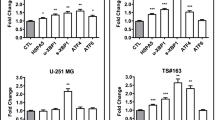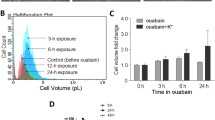Abstract
Lysosome-associated membrane protein (LAMP)-1, one of the major protein components of the lysosomal membrane, is upregulated in the human glioblastoma cell lines, U-373 MG and LN-Z308, which undergo cisplatin-induced apoptosis. These human brain tumor cell lines demonstrated apoptosis in response to cisplatin/nifedipine treatment. Both cell lines demonstrated an apoptotic response by more than one criterion. Apoptosis was demonstrated by DNA fragmentation techniques such as DNA laddering, ApopTag® in situ labeling, and an ELISA-based method of detecting liberated oligosomes. These cells also had characteristic morphologic changes and upregulation of bax consistent with apoptosis. LAMP-1 expression at the protein and mRNA level was examined and found to increase with cisplatin/nifedipine treatment. LAMP-1 expression was examined using indirect immunofluorescent staining, Northern blot analysis and Western blot analysis. The finding of an augmentation of LAMP-1 in these cells induced to die is enigmatic. These findings raise the possibility of LAMP-1 involvement in the apoptotic process.
Similar content being viewed by others
References
Akasaki K, Yamaguchi Y, Furuno K, Tsuji H. Purification, some properties, and tissue distribution of a major lysosome-associated membrane glycoprotein (r-lamp-2) of rat liver. J Biochem 110:922–927;1991.
Barry MA, Behnke CA, Eastman A. Activation of programmed cell death (apoptosis) by cisplatin, other anticancer drugs, toxins and hyperthermia. Biochem Pharmacol 40:2353–2362;1990.
Bredel M, Pollack IF, Freund JM, Hamilton AD, Sebti SM. Inhibition of Ras and related G-proteins as a therapeutic strategy for blocking malignant glioma growth. Neurosurgery 43:124–132;1998.
Cha Y, Holland SM, August JT. The cDNA sequence of mouse LAMP-2. Evidence for two classes of lysosomal membrane glycoproteins. J Biol Chem 265:5008–5013;1990.
Chen JW, Cha Y, Yuksel KU, Gracy RW, August JT. Isolation and sequencing of a cDNA clone encoding lysosomal membrane glycoprotein mouse LAMP-1. Sequence similarity to proteins bearing onco-differentiation antigens. J Biol Chem 263:8754–8758;1988.
Chen JW, Chen GL, D'Souza MP, Murphy TL, August JT. Lysosomal membrane glycoproteins: Properties of LAMP-1 and LAMP-2. Biochem Soc Symp 51:97–112;1986.
Chen JW, Murphy TL, Willingham MC, Pastan I, August JT. Two lysosomal membrane glycoproteins, LAMP-1 and LAMP-2, identified by monoclonal antibodies. J Cell Biol 101:85–95;1985.
Chen JW, Lin J, Madamanchi N, Trier TT, Campbell G. Apoptosis occurs in a new model of thermal brain injury. J Biomed Sci 7:459–465;2000.
Chen JW, Pan W, D'Souza MP, Murphy TL, August JT. Lysosome associated membrane proteins: Characterization of LAMP-1 of macrophage P388 and mouse embryo 3T3 cultured cells. Arch Biochem Biophys 239:574–586;1985.
Chirgwin JM, Pryzbyla AE, MacDonald RJ, Rutter WJ. Isolation of biologically active ribonucleic acid from sources enriched in ribonuclease. Biochemistry 18:5294–5299;1979.
Church GM, Gilbert W. Genomic sequencing. Proc Natl Acad Sci USA 81:1991–1995;1984.
Cuervo AM, Dice JF. A receptor for the selective uptake and degradation of proteins by lysosomes. Science 273:501–503;1996.
Fukuda M. Lysosomal membrane glycoproteins: Structure, biosynthesis, and intracellular trafficking. J Biol Chem 266:21327–21330;1991.
Fukuda M, Viitala J, Matteson J, Carlsson SR. Cloning of cDNAs encoding human lysosomal membrane glycoproteins, h-lamp-1 and h-lamp-2. Comparison of their deduced amino acid sequences. J Biol Chem 263:18920–18928;1988.
Goldenthal KL, Hedman K, Chen JW, August JT, Willingham MC. Post-fixation detergent treatment for immuno-fluorescence suppresses localization of some integral membrane proteins. J Histochem Cytochem 33:813–820;1985.
Gorman A, McCarthy J, Finucane D, Reville W, Cotter TG. Morphological assessment of apoptosis. In: Cotter TG, Martin SJ, eds. Techniques in Apoptosis — A User's Guide. London, Portland Press, 125–133;1996.
Himeno M, Noguchi Y, Sasaki H, Tanaka Y, Furuno K, Kono A, Sakaki Y, Kato K. Isolation and sequencing of a cDNA clone encoding 107 kDa sialoglycoprotein in rat liver lysosomal membranes. FEBS Lett 244:351–356;1989.
Isaac EL, Karageorgos LE, Brooks DA, Hopwood JJ, Meikle PJ. Regulation of the lysosome-associated membrane protein in a sucrose model of lysosomal storage. Exp Cell Res 254:204–209;2000.
Kondo S, Yin D, Morimura T, Kubo H, Nakatsu S, Takeuchi J. Combination therapy with cisplatin and nifedipine induces apoptosis in cisplatin-sensitive and cisplatin-resistant human glioblastoma cells. Br J Cancer 71:282–289;1995.
Kondo S, Yin D, Morimura T, Takeuchi J. Combination therapy with cisplatin and nifedipine inducing apoptosis in multidrug-resistant human glioblastoma cells. J Neurosurg 82:469–474;1995.
Konechi DS, Foetisch K, Schlotter M, Lichter-Konecki U. Complete cDNA sequence of human lysosome associated membrane protein-2. Biochem Biophys Res Commun 205:1–5;1995.
Kornfeld S, Mellman I. The biogenesis of lysosomes. Annu Rev Cell Biol 5:483–525;1989.
Lewis V, Green SA, Marsh M, Vihko P, Helenius A, Mellman I. Glycoproteins of the lysosomal membrane. J Cell Biol 100:1839–1847;1985.
Linnick MD, Zobrist RH, Hatfield MD. Evidence supporting a role for programmed cell death in focal cerebral ischemia in rats. Stroke 24:2002–2009;1993.
Lippincott-Schwartz J, Fambrough DM. Lysosomal membrane dynamics: Structure and interorganellar movement of a major lysosomal membrane glycoprotein. J Cell Biol 102:1593–1605;1986.
Mane SM, Marzella I, Bainton DF, Holt VK, Cha Y, Hildreth JEK, August JT. Purification and characterization of human lysosomal membrane glycoproteins. Arch Biochem Biophys 268:360–378;1989.
Mattei MG, Matterson J, Chen JW, Williams MA, Fukuda M. Two human lysosomal membrane glycoproteins, h-LAMP-1 and h-LAMP-2, are encoded by genes localized to chromosome 13q34 and chromosome Xq24–25, respectively. J Biol Chem 265:7548–7551;1990.
Noguchi Y, Himeno M, Sasaki H, Tanaka Y, Kono A, Sakaki Y, Kato K. Isolation and sequencing of a cDNA clone encoding 96 kDa sialoglycoprotein in rat liver lysosomal membranes. Biochem Biophys Res Commun 164:113–120;1989.
Ponten J, Macintyre EH. Long-term culture of normal and neoplastic human glia. Acta Pathol Microbiol Scand 74:465–486;1968.
Rao GN, Katki KA, Madamanchi NR, Wu Y, Birrer MJ. JunB forms the majority of the AP-1 complex and is a target for redox regulation by receptor tyrosine kinase and G protein-coupled receptor agonists in smooth muscle cells. J Biol Chem 274:6003–6010;1999.
Riss TL, Moravec RA. Comparison of MTT, XTT, and a novel tetrazolium compound MTS for in vitro proliferation and chemosensitivity assays (abstract); Mol Biol Cell 3(suppl)184;1992.
Sandoval IV, Chen JW, Yuan L, August JT. Lysosomal integral membrane glycoproteins are expressed at high levels in the inclusion bodies of I-cell disease fibroblasts. Arch Biochem Biophys 27:157–167;1989.
Sun N, Bruce AJ, Bauldry M, Schreiber SS. Isolation of the gene encoding lamp-1, a lysosomal membrane protein, by differential screening in an animal model of status epilepticus. Mol Brain Res 45:353–355;1997.
Tanaka Y, Guhde G, Suter A, Eskelinen EL, Harmann D, Lullmann-Rauch R, Janssen PM, Blanz J, von Figura K, Saftig P. Accumulation of autophagic vacuoles and cardiomyopathy in LAMP-2 deficient mice. Nature 406:902–906;2000.
Van Meir EG, Kikuchi T, Tada M, Li H, Diserens AC, Wojcik BE, Hunag HJ, Friedmann T, de Tribolet N, Cavenee WK. Analysis of the p53 gene and its expression in human glioblastoma cells. Cancer Res 54:649–652;1994.
Wyllie AH, Kerr JF, Currie AR. Cell death: The significance of apoptosis. Int Rev Cytol 68:251–306;1980.
Author information
Authors and Affiliations
Rights and permissions
About this article
Cite this article
Chen, J.W., Madamanchi, N., Madamanchi, N.R. et al. Lamp-1 is upregulated in human glioblastoma cell lines induced to undergo apoptosis. J Biomed Sci 8, 365–374 (2001). https://doi.org/10.1007/BF02258379
Received:
Accepted:
Issue Date:
DOI: https://doi.org/10.1007/BF02258379




